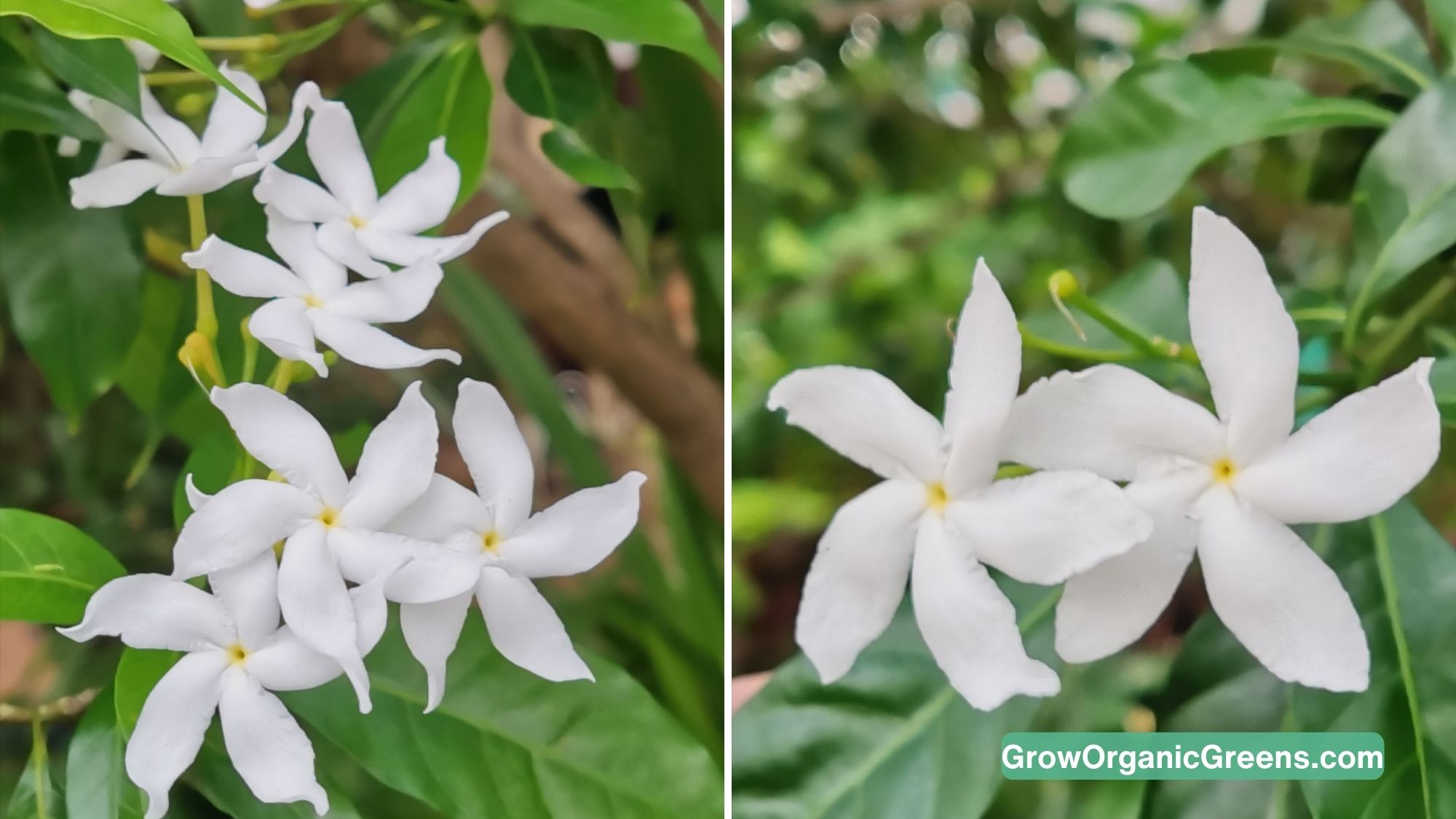Looking to add a touch of elegance and fragrance to your garden? Pinwheel Jasmine, also known as Tabernaemontana divaricata, could be the perfect choice. This perennial shrub is prized for its stunning, pinwheel-shaped flowers and glossy foliage. In this article, you will learn how to grow and care for Pinwheel Jasmine, ensuring it thrives and brings beauty to your outdoor space. For more insights, explore how to grow a jasmine flower plant and discover different varieties of jasmine.
Pinwheel Jasmine features white, pinwheel-shaped flowers with five slender petals. The buds are green and slender, opening into these beautiful and fragrant blooms. Its leaves are glossy, dark green, and oval-shaped, adding to the plant’s lush and elegant appearance.
Native
Native to India and Southeast Asia, Pinwheel Jasmine has a rich history of cultural significance and use.
Hardiness Zone
Pinwheel Jasmine thrives in USDA hardiness zones 9-11. Search your Hardiness Zone.
Annual/Biennial/Perennial
Pinwheel Jasmine is a perennial shrub, offering year-round beauty and fragrance.
Requirement at the Time of Plantation
For best results, plant Pinwheel Jasmine in well-drained, fertile soil. It prefers locations with full sun to partial shade. The ideal time for planting is in spring or fall, allowing the plant to establish itself during the growing season. Consider using the best watering system for a raised bed garden to maintain consistent soil moisture and learn how often you should water your garden.
Blooming Season
Pinwheel Jasmine blooms throughout the year in tropical climates, with peak blooming in spring and summer.
How to Take Care
To ensure optimal growth, provide Pinwheel Jasmine with full sun to partial shade. Apply a balanced NPK fertilizer in spring and summer to support its growth and flowering. Regular watering is essential, keeping the soil consistently moist but not waterlogged. Using organic mulch helps retain soil moisture and suppress weeds, contributing to the plant’s health.
Companion planting with other shrubs and perennials can enhance the visual appeal of your garden. Pinwheel Jasmine is suitable for mixed borders and as a standalone ornamental shrub, making it a versatile choice for various garden settings. Explore companion planting strategies to optimize your garden design.
Uses
- Aesthetic: Pinwheel Jasmine is highly valued for its unique pinwheel-shaped flowers and glossy foliage, making it a popular choice for gardens and as a hedge. Its lush, dark green leaves add a touch of elegance to any space, and its fragrant blooms can enhance the sensory experience of your garden.
- Medicinal: In its native regions, Pinwheel Jasmine is used in traditional medicine for various ailments, although it is not commonly used for medicinal purposes in other parts of the world.
- Culinary: Pinwheel Jasmine is not used for culinary purposes.
How to Propagate
Propagation of Pinwheel Jasmine can be achieved through cuttings. Take healthy cuttings from the plant and root them in well-draining soil to grow new plants. For more tips, explore pruning, deadheading, and pinching to maintain healthy growth.
Problems and Organic Solutions
Common pests include aphids and spider mites. These can be managed using neem oil or insecticidal soap. To prevent fungal diseases, ensure good air circulation around the plant and apply organic fungicides when necessary.
Special Facts
Pinwheel Jasmine is not just a visual delight but also holds cultural significance in many parts of India and Southeast Asia. It is often used in ornamental gardening for its beauty and fragrance.
Incorporating Pinwheel Jasmine into your garden can bring both visual splendor and a delightful fragrance. With its unique flowers and relatively easy care requirements, this perennial shrub is a wonderful choice for gardeners of all skill levels. Ready to transform your garden with the elegance and aroma of Pinwheel Jasmine? Start planting today and enjoy the stunning blooms and lush foliage.
Quick Facts Table
| Aspect | Details |
| Appearance | White, pinwheel-shaped flowers with five slender petals; green, slender buds; glossy, dark green, oval-shaped leaves |
| Native | India and Southeast Asia |
| Hardiness Zone | USDA zones 9-11 |
| Lifespan | Perennial shrub |
| Plantation Requirements | Well-drained, fertile soil; full sun to partial shade; plant in spring or fall |
| Blooming Season | Year-round in tropical climates, with peak blooming in spring and summer |
| Care Needs | Full sun to partial shade; balanced fertilizer in spring and summer; regular watering; organic mulch; companion planting with other shrubs and perennials |
| Uses | Unique pinwheel-shaped flowers; ornamental gardens, mixed borders, hedges |
| Propagation | Through cuttings |
| Problems & Solutions | Aphids and spider mites (neem oil, insecticidal soap); fungal diseases (good air circulation, organic fungicides) |
| Special Facts | Cultural significance in India and Southeast Asia; often used in ornamental gardening |

Misty S is the founder and lead writer at GrowOrganicGreens.com, a comprehensive gardening resource dedicated to helping people cultivate beautiful and sustainable gardens. She has a Master’s degree in Economics and specialized studies in agricultural economics, horticulture, and soil science. Drawing from her extensive knowledge and experience, Misty shares practical gardening tips on soil preparation, organic manure composting, fertilizers, plant care, and indoor gardening, making her advice accessible and helpful to gardeners of all levels.
Despite having an high-demanding 9-5 job, Misty dedicates her personal time to researching and exploring various gardening topics. Her keen interest in gardening has grown into a passion, driving her to help new gardeners and anyone interested in starting their gardening journey.
Follow Misty’s work and the latest gardening insights and updates on Pinterest. You can reach out to Misty at mistysblogging@gmail.com.

